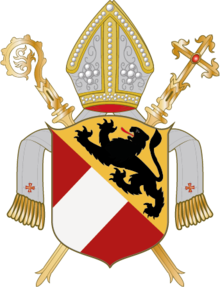- Lavant
-
This article is about the prince-bishopric. For other uses, see Lavant (disambiguation).
Lavant (in Latin Lavantina) was a prince-bishopric, suffragan of the Prince-archbishop of Salzburg, then in the southern part of imperial Austria's Styria. Later the area was re-assigned to presentday Slovenia. It became the Slovenian bishopric of Maribor, a suffragan of the Archbishop of Ljubljana, on 5 March 1962. On 7 April 2006 the diocese was elevated to the Archdiocese of Maribor.
History
The original seat of the bishopric lay in the eastern part of Carinthia in the valley of the Lavant. It was here that Eberhard II, Archbishop of Salzburg, established, 20 August 1212, at St. Andrä, with the consent of Pope Innocent III and Emperor Frederick II, a collegiate chapter, the canons of which followed the Rule of St. Augustine; its members were chosen from the cathedral chapter of Salzburg. On account of the great remoteness and the difficulty of travelling, the Archbishop, about the year 1223, asked Pope Honorius III to allow him to found a bishopric at St. Andrä. After the pope had had the archbishop's request examined by commissioners, and had given his consent, Eberhard drew up the deed of foundation, 10 May 1228, wherein he secured the possession of the episcopal chair for himself and his successors in perpetuity. He named as first bishop his court chaplain Ulrich, who had formerly been priest of Haus, in Styria (died 1257).
In the deed of foundation of the new bishopric, no boundaries were defined. In a deed of Archbishop Frederick II of Salzburg of 1280, seventeen parishes, situated partly in Carinthia and partly in Styria, were described as belonging to Lavant; the extent of the diocese was rather small, but the bishops also attended to the office of vicar-general of the Archbishops of Salzburg for some scattered districts; they also frequently attended to the office of Vicedom (bishop's deputy in secular affairs) at Friesach.
The tenth bishop, Dietrich Wolfhauer (1318–32), is mentioned in deeds as the first prince-bishop; he was also secretary of Frederick III the Handsome, of Austria, and was present at the battle of Mühldorf in 1322. Since the twenty-second bishop, Theobald Schweinbeck (1446–63), the bishops have borne without intermission the title of Fürst (prince).
The following prominent bishops deserve special mention: the humanist Johann I von Rott (1468–82), died as Prince-Bishop of Breslau; Georg II Agrikola (1570–84), who after 1572 was also at the same time Bishop of Seckau; Georg III Stobäus von Palmburg (1584–1618), a worthy promotor of the Counter-Reformation; Maximilian Gandolph Freiherr von Kienburg (1654–65), did much towards increasing the financial resources of the diocese.
By the new regulations under Holy Roman Emperor Joseph II, several bishoprics were added to the Diocese of Lavant. Prince-Archbishop Michael Brigido of Laibach in 1788 ceded a number of parishes in the southern part of what is now the Diocese of Lavant; and the district of Völkermarkt, which was afterwards again detached, was added to the bishopric at that time.
The extent of the diocese was changed by the circumscription of 1 June 1859. The valley of the Lavant and the district of Völkermarkt in Carinthia fell to Gurk; in consequence of which the District of Marburg was transferred from Seckau to Lavant; since then the diocese comprises the whole of southern Styria. By the decree of the Congregation of the Consistory of 20 May 1857, the see of the bishop was removed from St. Andrä to Marburg; the parish church of St. John the Baptist in that place being elevated into a cathedral, and the title "of Lavant" being preserved. On 4 September 1859, Bishop Anton Martin Slomschek (1846–62) made his solemn entry into Marburg. His successors, Jakob Maximilian Stepischnegg (1862–89), and Michael Napotnik (since 1889) have shown great zeal for the promotion of the spiritual life by introducing religious orders and founding educational and charitable institutions and clubs. But the most beneficial work done for the religious life of the diocese was that of the diocesan synods, held by Stepischnegg (1883), and by Napotnik, who followed his example (1896, 1900, 1903, and 1906).
The old cathedral chapter, which was composed of the canons of the Augustinian order, was dissolved in 1808, and its property was assigned to the "Religionsfond" founded by Joseph II; in 1825 a new cathedral chapter was provisionally erected, and definitively so in 1847.
The most prominent ecclesiastical buildings in the diocese are: the cathedral and parish church of St. John the Baptist, at Marburg, which was begun in the middle of the twelfth century as a Romanesque basilica, rebuilt after 1520 in the Gothic style, again restored after the fire in 1601, and once more in 1885; the provostship and parish church of St. Georg, at Pettau, erected in the Gothic style about 1314; the abbey and parish church of St. Daniel, at Cilli, dates from the middle of the sixteenth century; and the shrine of St. Maria der Wüste, in the neighbourhood of Marburg (built 1628), in the baroque style.
Present statistics
In 2004, the diocese of Maribor had 704,384 Catholics of 826,229 people (= 85.3 % of inhabitants), 311 diocesan and 93 regular priests, 4 permanent deacons, 109 male 134? and 290 female members of religious orders. On April 7, 2006 Pope Benedict XVI. elevated the diocese to an archdiocese with the new suffragan dioceses of Celje and Murska Sobota.
Sources
 "Lavant". Catholic Encyclopedia. New York: Robert Appleton Company. 1913.
"Lavant". Catholic Encyclopedia. New York: Robert Appleton Company. 1913.- Catholic Hierarchy
 This article incorporates text from a publication now in the public domain: Herbermann, Charles, ed (1913). "Lavant". Catholic Encyclopedia. Robert Appleton Company.Categories:
This article incorporates text from a publication now in the public domain: Herbermann, Charles, ed (1913). "Lavant". Catholic Encyclopedia. Robert Appleton Company.Categories:- Roman Catholic dioceses in the Holy Roman Empire
Wikimedia Foundation. 2010.

